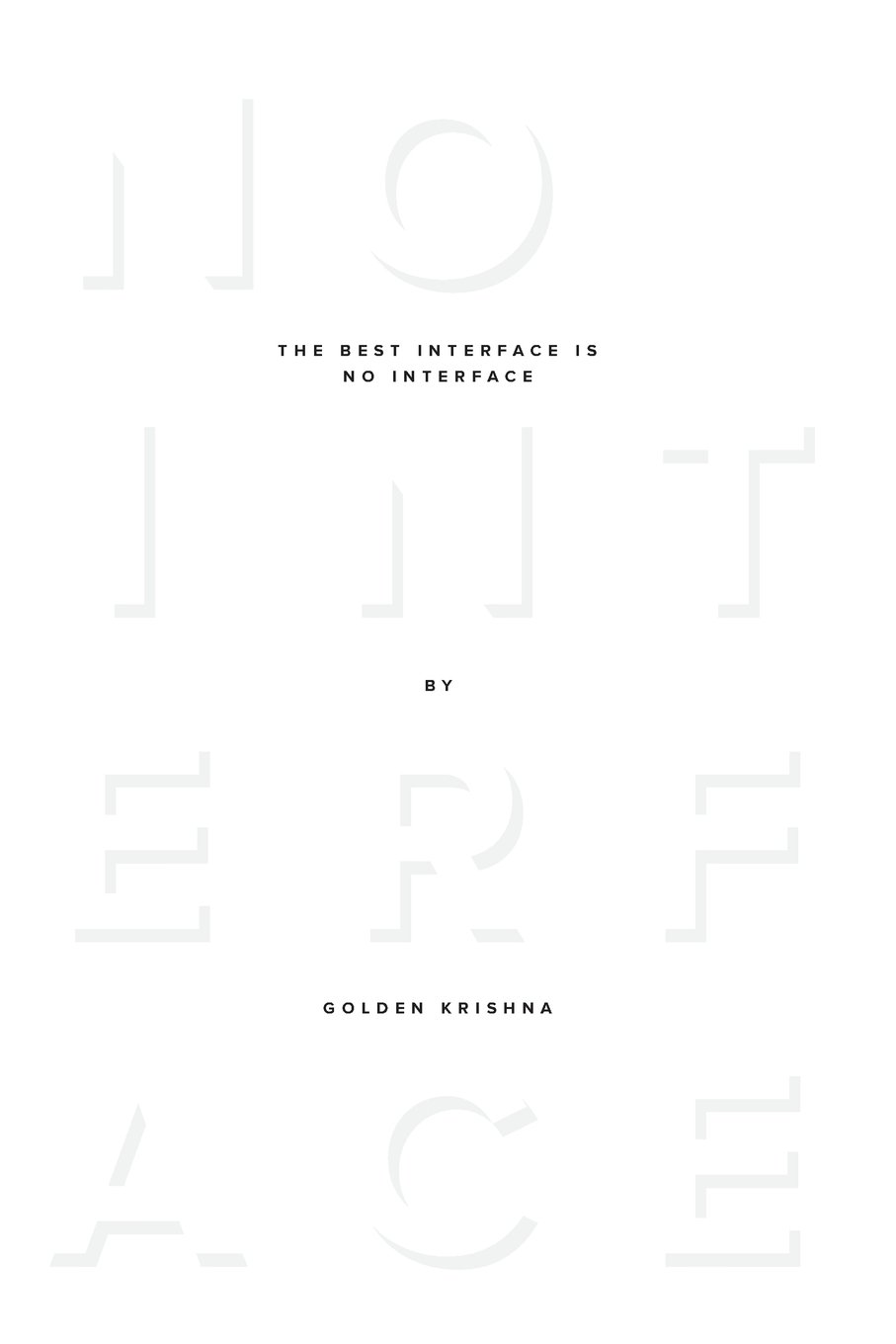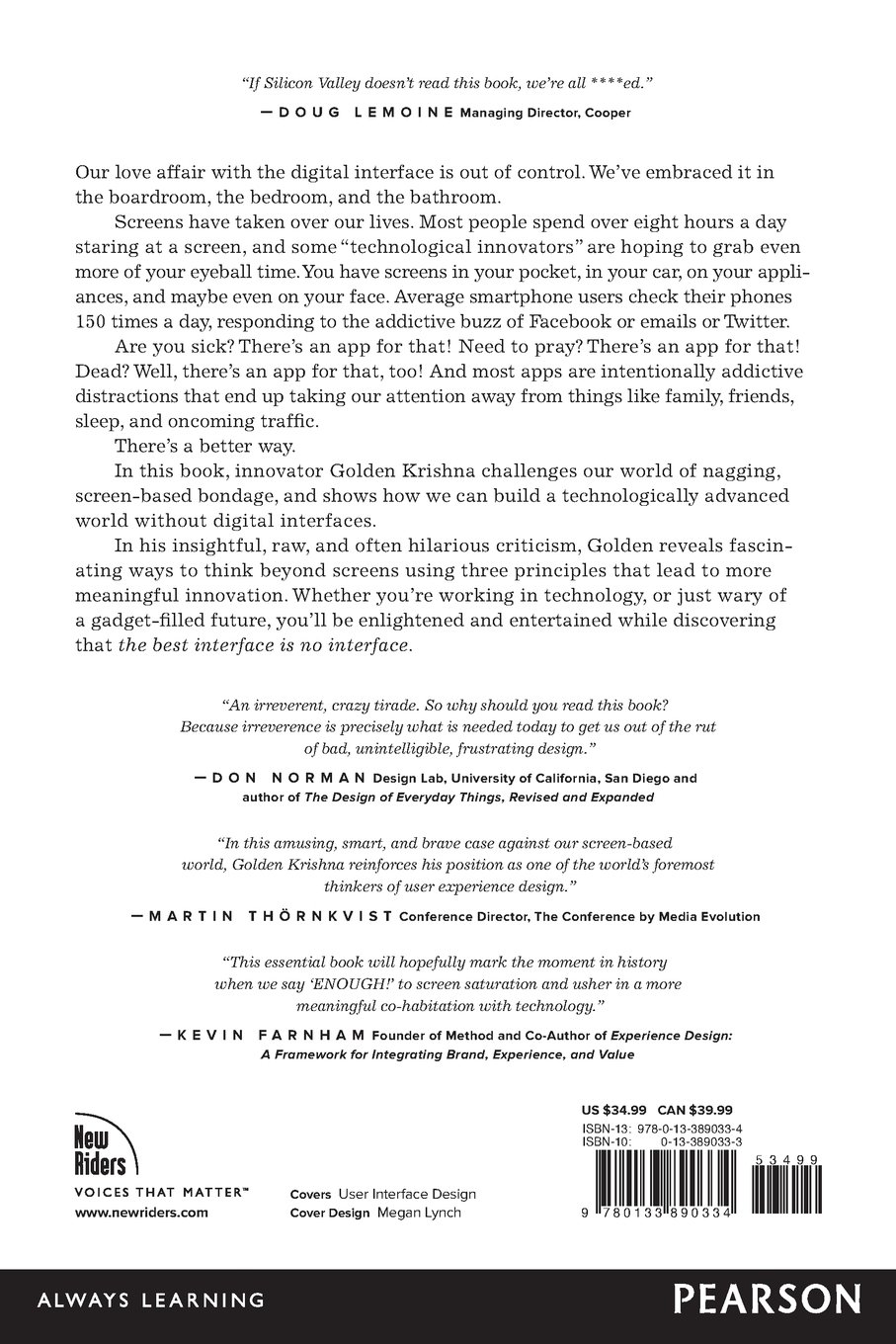Customer Services
Copyright © 2025 Desertcart Holdings Limited
Desert Online General Trading LLC
Dubai, United Arab Emirates



Full description not available
O**D
A hilarious and insightful exploration of how to design for humans
Lucidly written and punctuated with a combination of artfully-executed humor and a biting sarcasm that's badly needed in an industry that often takes itself too seriously, Krishna's book appeals to an audience broader than technology executives, designers, and developers. Of course, it's people who fill these roles professionally that need to pay attention. Those of us who conceive and design and build software, websites, apps should think a lot harder about why we're doing anything in the first place. Sadly, the problem with so much of the tech world is that the obsession is with the wizardry of the "how" rather than a thoughtful contemplation about whether or not people really need an app for that.Throughout the narrative, Krishna outlines the silliness of tech's obsession with putting screen-based interfaces on things that probably don't need them--take for instance the 17" touchscreen in the center console of a Tesla--and then offers real-world examples of more invisible and far more useful technology. It's a great way to mix necessary criticism of an industry that has lots of mental processing power but deficient conscience, with actionable, tenable solutions.For anyone getting into "experience design" or "UX/UI" or whatever it's called these days, this is a better and more important read than another book on nifty tricks with CSS and Javascript. It's a dose of sanity, and a really fun one at that.
N**N
A clear critique of screen-centric thinking, and new ideas about how to move forward
There’s this general worry that people spend too much time looking at their phones. And a lot of people accept this decade-old behavior as sort of a cost of doing business, the price we pay for all the happiness and efficiency and entertainment we get from these glowing slabs.In “The Best Interface,” a sharp and incisive critique of screen-based design thinking, Golden Krishna points out that designing digital products has morphed into a discipline of maximizing time and attention on screens, which is often in complete opposition to helping people solve problems or accomplish goals. Design has turned into a science of addiction rather than the art (and science) of empathy and human needs.Mr. Krishna’s witty, irreverent delivery belies a serious message, and it gets at the heart of this vague concern about where digital culture is headed, and how it feels like we’re headed in the wrong direction. The significant contribution of “The Best Interface” is that it not only identifies the problematic trend -- he’s not the first to talk about it -- but, critically, gives us a vision of the future where this trend is not inevitable, and a template for creating this future. His breakthrough is in doing that thing that in hindsight seems so obvious: reject the premise that digital solutions should start with imagining the corresponding interface, then follow that line of thinking to its natural conclusions.This book is food for thought, if by “food” you mean a 12-course feast with wine pairing. It is full of heady, simple ideas with practical power, and if you want to be a better designer, product manager, venture capitalist, or human, you’ll want to sit and digest it.
D**E
Towards an information future beyond the screen!
What good is all our computational power if our best minds are consumed building more “lazy rectangles” for screens? Problem solving and tool making have all been channeled into flatland. Golden Krishna calls out the absurdity of our current screen-based thinking when applied unrelentingly in almost every aspect of our already screen-oriented lives. His call for no UI computing laid out here in performative, pictographic formulations is stirring in a deeply funny way. With so many of us living in or close to “peak screen” — the point when there are no more waking hours left to stare into screens — the process of reengaging with our bodies and the physical worlds around us requires a fundamental change in how we conceive and deliver human-computer interactions.This book get's right to the point and presents an important challenge for anyone with in interest in shaping better experiences and interfaces. An indispensable read for gaining a clear and whole understanding how screen based information design is limiting our potential as thinkers and makers. This book has helped me realize just how much potential awaits beyond peak screen.
S**R
A manual for doing it better.
There is no practical guide to good design. Yes, this book is a manifesto, and an important one. Designing in the corporate world, I've long been fatigued with screen-based thinking and ignoring the right answer because it's hard. This book won't give you the answers to your design problems, but it does encourage you to keep trying, because it's important.As designer practitioners, we are now more than ever able to directly impact the daily lives and experiences of customers in meaningful ways. But steer clear of artificial, manufactured meaning. The final chapter, in which Krishna writes about Automatic solutions, was by far my favorite reminder that, as a designer of complex financial systems, I am working to make hard things easy for people, and that will take some novel thinking. Not hype, not marketing, not an easy answer. Deep understanding, thoughtful research and insights paired with a good design process and a team of people committed to making the right solution are the key, and with No Interface as a philosophy, the ideas are bound to be more innovative.
A**R
If you like unconventional approach to design and life in general as ...
If you like unconventional approach to design and life in general as well as interesting case studies from big players, this is a book you are going to love. As a User Experience and App designer I found it very challenging at first to agree with ideas presented in the book by Golden but after reading a bit more I came to conclusion that this is a very fresh and innovative concept and it is not at all diminishing current processes in design world but it creates an interesting perspective on where we should be in the future and how important is the role of UX in designing for people. Great read.
C**A
Worth the money!
Gives you a new perspective when it comes to designing interfaces. In a world obsessed with putting screens on everything, this is a breath of fresh air. Would definitely recommend this!
E**.
Not a instruction manual - Just the best Think-piece about the future of UX out there
Don't read this book expecting a practical guide to User Experience and Interface design. What this is, is a clever and fun to read treatise on what Ux should be like. By using good and bad examples Golden Krishna makes you rethink what the User Experience Gold standard ( pardon the pun) should be. I get really excited by a future when all tech companies follow the NoUI idea.
P**R
A provocative, funny and iconoclastic look at the future of design
Really good and thought-provoking book. Any budding designer should read it.
M**G
Inspiration
Inspiration and provide me a lot to think of when I work on UX design project.
Trustpilot
2 weeks ago
3 weeks ago